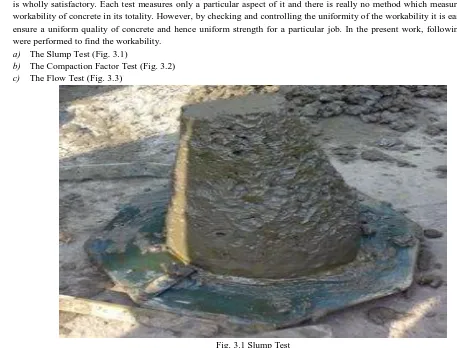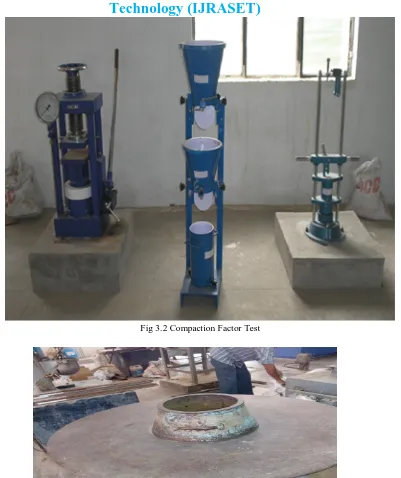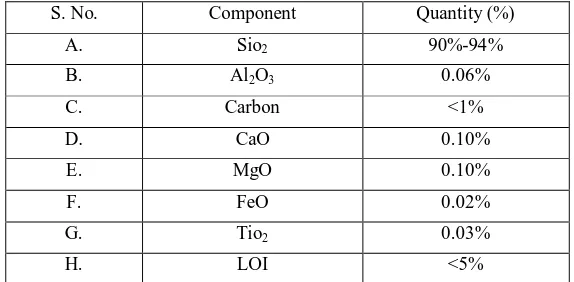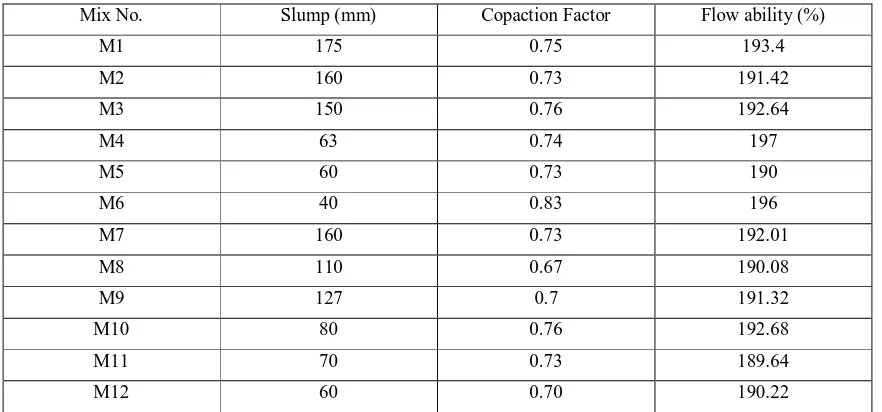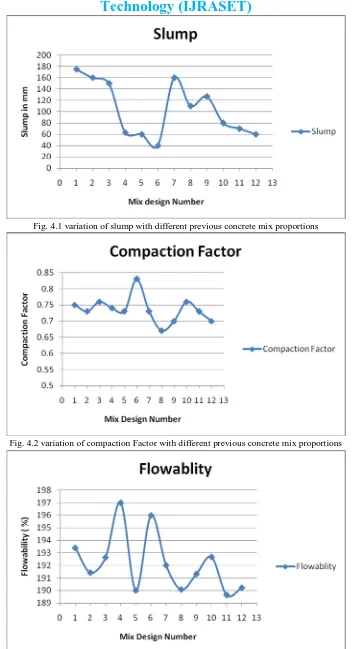Experimental Study of Pervious Concrete
Pavement
Vikram1, Mahla R.P.*2
1
M. Tech Student, Department of Civil Engineering, OITM/GJU- Hisar (125001), Haryana, India
2
Department of Civil Engineering, OITM/GJU- Hisar (125001), Haryana, India.
Abstract— Concrete is a widely used structural material consisting essentially of a binder and a mineral filler. Concrete has
been the leading material since it was used and is bound to maintain its significant role in the upcoming future due to its durability, adaptability to any shape and size and many other applications. It is a composite material produced by mixing cement, inert matrix of sand and gravel or crushed stone. Pervious concrete is a type of concrete that has a low water-cement ratio and contains none or very little amount of sand. This concrete has a light colour and open-cell structure because of which they do not absorb heat from the sun; they also do not radiate the heat back into the atmosphere, which reduces heating in the environment. Pervious concrete has low installation costs. In addition, it filters the storm water thus reducing the number of pollutants entering the rivers and ponds. Pervious concrete also improves the growth of trees. In the present study the behaviour of pervious concrete has been studied experimentally. Various mix proportions were prepared by replacing cement with silica fume (6% by the weight of cement), by adding super plasticizers (0.13% & 0.25%) and varying size of aggregates. The water-cement ratio was kept constant 0.34. Different properties of pervious concrete e.g. workability, compressive strength, split tensile strength, flexural strength test at 7, 28 & 56 days and bond strength tests at 28 & 56 days have been studied experimentally. Experimental results showed that strength of pervious concrete decreased with the addition of silica fume (6%) and super plasticizers (0.13% & 0.25%). The mix proportions with aggregates size (4.75 mm to 10 mm) gives higher strength when compared to mixes with aggregates size (10 mm to 20 mm) and (4.75 mm to 20 mm) respectively.
Keywords— Concrete, Slump Test, Silica Fume, Super Plasticizers Compaction Factor Test, Water Cement Ratio,
I. INTRODUCTION
II. REVIEWOFLITRATURE
In 1988, Meininger studied the effect of different aggregate sizes (10mm and 19mm) on hardened properties of non-fine concretes and the results showed that compressive strength reduces with increase in aggregates size, which corresponded with the results found from Yang & Jing (2003). It claimed the decrease of aggregate size led to higher pervious concrete strength, resulting from the increase of the interface strength between the aggregate and cement paste.
In 2003, Jing Yang and Guoliang Jiang studied that by using the common material and method, the strength of the pervious concrete is low. But using smaller aggregate, silica fume and super plasticizer in the previous concrete strength can be increased greatly. Also by increasing the cement paste binder area and enhancing the strength of cement binder pervious concrete strength can also be increased. The pervious pavement materials that composed of a surface layer and a base layer were made. The compressive strength of the pervious concrete can reach 50 MPa and the flexural strength 6MPa.
In 2004, D. Tennis Paul et. al. studied the replicated simples of pervious concrete formed from two rock sources for coarse aggregates and different size fractions to determine hydrologic relationships. Linear relationships were found between density and porosity, density and permeability, porosity and permeability, porosity and specific yield. The results suggest that properties such as permeability, porosity and specific yield are not significantly affected by different aggregate types.
In 2006 Luck J.D., Workman S.R. conducted laboratory study to evaluate the properties of high performance porous concrete. They used optimum mixture proportions in the preparation of high performance porous concretes containing three sizes of coarse aggregates with appropriate amount of high water-reducing and thickening agents. Its strength development rate was also examined at curing age 1, 3, 7, 14 and 28 days at 20o C and 60% relative humidity. Consequently high performance porous concrete exhibited good workability and cohesiveness with no segregation or bleeding and developed high strength compared to conventional porous concrete.
In 2008, Kevern J. T., Schaefer V.R. et. al. studied the engineering properties of the aggregate of selected concrete mixtures. Concrete mixtures consist of single-sized river gravel aggregate 4.75 mm and constant binder contents, together with high range water reducer. River sand was used as a replacement for up to 7% coarse aggregate. Two different types of polypropylene fibres, a shorter fibrillated variable-length and a longer fibrillated single-legth were incorporated at several addition rates from 0 to 0.1% by volume of concrete. The results indicate that the use of sand and fibres provided beneficial effects on pervious concrete properties including increased strength, maintained or improved permeability and enhanced freeze-thaw resistance. Use of the short fibres improved the strength, permeability and freeze-thaw durability of the mixtures which did not contain additional sand. The long fibres improved the strength and freeze thaw durability of the mixtures which did not contain additional sand but did not improve permeability.
In 2009, Kevern J.T., Schaefer R et. al. studied the current methods of curing pervious concrete is to cover with plastic for 7 days, although no studies have been performed to determine if that is sufficient or even required. They presented results of combinations of four different pervious concrete mixtures cured using six common curing methods. The surface abrasion of the concrete was tested using a rotary cutter device according to ASTM C944. The results show that the concrete abrasion resistance was improved with a majority surface-applied curing compounds; however the surfaces covered with plastic sheets produced the lowest abrasion levels. A majority of the curing regimes also produced higher flexural strength than the control concrete. The best abrasion resistance and higher strength overall was obtained with the mixture containing fly ash and cured under plastic for 28 days.
In 2010, Omkar Deo, Narayanan Neithalath studied that the properties of pervious concrete are strongly dependent on its pore structure features, porosity being an important one among them. Several pervious concrete mixtures with different pore structure features are proportioned and subjected to static compression tests. The compressive stress-strain response of pervious concretes, a model to predict the stress-strain response and its relationship to several of the pore structure features are outlined. A statistical model was used to relate the compressive strength to the relevant pore structure features. It was observed that a proper understanding of the influence of pore structure features on compressive response can lead to optimized material design for the desired properties.
III.EXPERIMENTALPROGRAMME
experimental studies has been discussed in this chapter.
Table 3.1: Typical Pervious Concrete Materials Proportions (ACI 2010) Mix Constituent or Design Parameter Range
Coarse aggregate 1180 to 1475 kg/m3
Cementations materials 265 to 413 kg/m3
Water-cement ratio 0.28-0.34
Cement-Aggregate ratio 1:4
Table 3.2: Aggregates size
S. No. Aggregates size (mm)
1. 4.75 to 10
2. 10 to 20
3. (4.75 to 10) + (10 to 20)
IV.METHODOLOGY
A. Testing of Fresh Pervious Concrete
1) Workability: A number of different methods are available for measuring the workability of fresh concrete, but none of them is wholly satisfactory. Each test measures only a particular aspect of it and there is really no method which measures the workability of concrete in its totality. However, by checking and controlling the uniformity of the workability it is easier to ensure a uniform quality of concrete and hence uniform strength for a particular job. In the present work, following test were performed to find the workability.
a) The Slump Test (Fig. 3.1)
b) The Compaction Factor Test (Fig. 3.2)
[image:4.612.68.525.339.687.2]c) The Flow Test (Fig. 3.3)
Fig 3.2 Compaction Factor Test
Fig. 3.3 Flow Table Test
B. Materials Used
Table 3.3 Physical properties of Cement
S. No. Properties Observed values Values specified by IS: 8112-1989
1. Fineness% 5 Not more than 10
2. Normal consistency% 28 -
3. Initial Setting Time (minutes) 158 >=30
4. Final setting Time (minutes) 208 <=600
5. Compressive Strength (MPa)
3 days 7 days 24.3 34.8 >23 >33
6. Specific gravity (Le-Chatelier’s Method)
3.11 -
2) Water: The water to be used for casting should be free from organic matter. Potable water is generally considered satisfactory as per clause no. 5.4 of IS 456-2000. Tap water available in the laboratory was used for mixing the ingredients of concrete and curing of the specimens.
3) Silica Fume: Silica fume is a by-product in the carbo- thermic reduction of high-purity quartz with carbonaceous materials like coal, coke, wood-chips in electric arc furnaces in the production of silicon and ferrosilicon alloys. Silica fume is also known as micro silica, is an amorphous (non-crystalline) polymorph of silicon dioxide, silica. Silica fume is an ultrafine material with spherical particles less than 1 μm in diameter, the average being about 0.15 μm. This makes it approximately
100 times smaller than the average cement particle. The bulk density of silica fume depends on the degree of densification in the silo and varies from 130 to 600 kg/m3. The specific gravity of silica fume is generally in the range of 2.2 to 2.3. Silica fume available at KGR Fusion, Ludhiana has been used in the present study. Physical properties and chemical composition of silica fume used have been shown in Table 3.4 (a) & 3.4 (b) respectively.
Table 3.4 (a): Physical properties of Silica Fume (KGR Fusion, Ludhiana)
S. No. Property Observed Value
1. Colour Light grey
2. Fineness% Below 45 microns
3. Specific gravity (Le-Chatelier’s Method 2.17
4. Bulk Density 550 to 700 kg/m3
5. Moisture content 0.1 to 3%
Table 3.4 (b): Chemical composition of Silica fume (KGR Fusion, Ludhiana)
S. No. Component Quantity (%)
A. Sio2 90%-94%
B. Al2O3 0.06%
C. Carbon <1%
D. CaO 0.10%
E. MgO 0.10%
F. FeO 0.02%
G. Tio2 0.03%
[image:6.612.112.500.435.530.2] [image:6.612.162.449.567.708.2]4) Super Plasticizers: Super plasticizers, also known as high range water reducers, are chemicals used as admixtures where well-dispersed particle suspensions are required. These polymers are used as dispersants to avoid particle aggregation and to improve the flow characteristics of suspensions such as in concrete applications. This effect drastically improves the performance of the hardened fresh paste (Wikipedia, the free encyclopedia). Cico plast super is used for producing extremely flow able concrete, pumped concrete, pre-stressed and denser concrete as well as in industrial commercial flooring and floor toppings. Cico plast super is new generation concrete admixture based on modified Sulphonated naphthalene formaldehyde, combining the properties of super plasticizers with high degree of slump retention characteristics, high range water reducer and also acts as water proofers for concrete, conforms to ASTM C-494. Specification: complying with IS: 9103-2003, IS: 2645-2003 has been used in the present study.
a) Features
i. Improves workability and flow properties without any increase in water.
ii. Increase in bond strength of concrete to reinforcing steel.
iii. Reduction of internal friction and thixotropy without the risk of segregation and making concrete workable.
iv. Minimize shrinkage or cracking.
v. Suitable for use in concrete above and below ground.
b) Uses
i. It produces extremely workable and flowing concrete without loss of strength.
ii. It can be used to produce pumpable concrete or at locations where flowable or high strength concrete is needed.
V. EXPERIMENTALRESULTS
Specimens corresponding to various previous concrete mix proportions were subjected to distructive testing to evaluate the influence of silica fume (6% by the weight of cement) and super plasticizers (0.13% & 0.25%) on the various mechanical properties of the concrete such as compressive strength, , flexural variation of workability, compressive strength, and bond strength of different concrete mix with age.
Workability-The workability of the concrete mix was measured by slump test, compaction factor and flow table test. The slump of the concrete mix decreased with the addition of silica fume (6% of content) and 0.13% of super plasticizers. It has been observed that with the addition of silica-fume, the previous concrete becomes sticky. The loss in slump of fresh concrete was primarily attributed to the high surface area of the silica fume which absorbs more mixing water. The workability improved with the addition of 0.13% & 0.25% of super plasticizers because the sulfonic acid groups present in it were responsible for of super plasticizers because the sulfonic acid groups present in it were responsible for neutralizing the surface charges on the cement particles and this reduced the viscosity of the paste and concrete. The ability of super plasticizers to increase the slump of concrete depends on factors as the type, dosage, and time of addition of super plasticizer; w/c; and the nature or Amount of cement. It has been found that for most types of cement, super plasticizers improve the workability of concrete.
[image:7.612.87.528.515.721.2]Table 4.1 gives the workability of different concrete mixes. Fig. 4.1-4.3 shows the variation of slump, compaction factor and flow ability respectively.
Table 4.1: Workability of various previous concrete mix proportions
Mix No. Slump (mm) Copaction Factor Flow ability (%)
M1 175 0.75 193.4
M2 160 0.73 191.42
M3 150 0.76 192.64
M4 63 0.74 197
M5 60 0.73 190
M6 40 0.83 196
M7 160 0.73 192.01
M8 110 0.67 190.08
M9 127 0.7 191.32
M10 80 0.76 192.68
M11 70 0.73 189.64
Fig. 4.1 variation of slump with different previous concrete mix proportions
Fig. 4.2 variation of compaction Factor with different previous concrete mix proportions
Slump for M4, M5 and M6 has been decreased by 64%, 63% & 73% in comparison to M1, M2 and M3 respectively. The slump of w.r.t. M1, M2 and M3 and increased by 60%, 45% & 68% respectively w.r.t. M4, M5 and M6. The slump of concrete M10, M11 and M12 decreased by 54%, 56% and 60% respectively w.r.t. M1, M2 and M3 and increased by 21%, 13% and 4% respectively in comparison to M4, M5 and M6 respectively. Compaction factor of previous concrete mix was increased as silica fume is added to the concrete mixes. Compaction factor of concrete mixes decreased with 0.25% of super plasticizers and again decreased with 0.13% of super plasticizers to concrete mix. Flowability of previous concrete mix proportions increased with the addition of silica fume. Flowablity of previous concrete decreased with the addition of 0.25% of super plasticizers and increased with 0.13% of sugar plasticizers.
VI.CONCLUSIONS
The following conclusions have been drawn based on the observation and discussion of the test result:
A. Slump of previous concrete mix proportions decreased with the addition of silica flume.
B. Slump of previous concrete mix proportions increased with addition of 0.25% of super plasticizers and again decreased with addition of 0.13% of super plasticizers.
C. Compaction Factor of previous concrete mix proportions was increased with the addition of silica fume.
D. Compaction Factor of concrete mix proportions decreased with 0.13% of super plasticizers and again decreased with 0.25% of super plasticizers to previous concrete mixes for the concrete mixes.
E. Flowability of previous concrete mix proportions increased with the addition of silica flume.
F. Flowablity of previous concrete decreased with the addition of 0.25% of super plasticizers and increased with 0.13% of super plasticizers.
G. The compressive strength of previous concrete decreased by 25% with the addition of silica fume for small size aggregates (4.75 mm to 10 mm). The compressive strength of previous concrete decreased by 27% and 28% with the addition of super plasticizers 0.25% and 0.13% respectively.
H. The compressive strength of previous concrete decreased by 18% with addition of silica fume and also decreased 17% and 18% with the addition of super plasticizers 0.25% and 0.13% respectively for large size (10 mm to 20 mm) aggregates.
I. The compressive strength of previous concrete decreased by 16% with addition of silica fume and also decreased by 21% and 22% with the addition of super plasticizers 0.25% and 0.13% respectively for all-in (4.75 mm to 20 mm) aggregates..
J. At 6% replacement of cement by silica fume, bond strength of concrete mix was decreased approximately by 50% and also decreased approximately by 17% % 7% with the use of 0.25% &0.13% super plasticizers at 28 and 56 days with respect to control mix for small (4.75 mm to 10 mm ) aggregates.
K. At 6% replacement of cement by silica fume and addition of 0.25% &0.13% super plasticizers, bond strength of previous concrete mix was decreased approximately by 50% and 15% % 7% at 28 and 56 days with respect to control mix for large (10 mm to 20 mm ) aggregates.
L. At 6% replacement of cement by silica fume and addition of 0.25% &0.13% super plasticizers, bond strength of previous concrete mix was decreased approximately by 44% and 9% & increased approximately by 24% respectively at 28 and 56 days with respect to control mix for all-in (4.75mm to 20mm ) aggregates.
M. The aggregates size 4.75mm to 10mm has more compressive strength as compared (4.75 mm to 20 mm) and 10mm to 20mm aggregates size.
N. The bond strength is more for aggregates size 10mm to 20mm and low for aggregates size (4.75mm to 20mm) and aggregates size for (4.75mm to 10mm).
O. The M4 and M7 can be used at places where moderate compressive strength is required e.g. pathways. These can also be used as sound absorbing walls in classrooms, auditorium etc. This can also be used at railway platforms. This will help in reducing water accumulation on railway tracks.
P. Scope for Further Study
The strength characteristics of previous concrete can be further studies by taking into account the following parameters:
1) By varying the water cement ratio.
2) By varying the amount of silica fume and super plasticizers.
3) Also changing the super plasticizers type.
4) By using some little amount of fine aggregates.
5) By using recycled coarse aggregates in the concrete mix as replacement of coarse aggregates.
6) Using the super plasticizers in the mixes only by removing silica fume.
REFERENCES
[1] Ajamu S.O., Jimoh A.A. “Evaluation of structural Performance of Previous Concrete in Construction” , International Journal of Engineering and Technology Volume 2 No. 5, May, 2012
[2] Ashley, E. 2008. “Using Previous Concrete to Achieve LEEDTM
points concrete in focus.” National Ready Mixed Concrete Association, Silver Spring, MD.
[3] Alan Sparkman Tennessee Concrete Association
[4] Ayda S. Agar Ozbek Jaap Weerhejim, Erik Schlangen, Klaas van Breugel, “Dynamic behaviour of porous concrete under drop weight impact testing” , Cement & Concrete Composites vol. 39, 2013, pp. 1-11
[5] Ayda S. Agar –Ozbek, Jaap Weerhejim, Erik Schlangen, Klaas van Breugel, “Investigating porous concrete with improved strength: Testing at different
scales” a construction and Building Materials Vol. 41, 2013, pp. 480-490
[6] Ayda S. Agar Ozbek Jaap Weerhejim, Erik Schlangen, Klaas van Breugel, “Dynamic behaviour of porous concrete under drop weight impact testing” , Cement & Concrete Composites vol. 39, 2013, pp. 1-11
[7] Alan Sparkman Tennessee Concrete Association
[8] Carsana M., Tittarelli F., Bertolini L., “Use of no-fines concrete as a building material: strength, durability properties adn corrosion protection of embedded steel”, Cement adn Concrete Reearch vol. 48, 2013, pp. 64-73
[9] Cellular concrete solutions
[10] Charger Enterprises
[11] Chindaprasirt P., Hatanaka s., “Cement paste characteristics and porous concrete properties”, Construction and Building Materails, vol. No. 22, 2008, pp. 894-901
[12] Carollinas Ready Mixed, Concrete Association.
[13] Chopra Manoj, “Compressive Strength of Previous Concrete Pavements,” Florida Department of Transportation. Retrieved 1 October 2012.
[14] Deo Omkar, Neithalath Narayanan, “Compressive response of previous concretes proportioned for desired porosities,” Construction and Building Materials vol. No. 25, 2011, p.p. 4181-4189.
